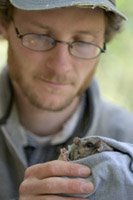I have just published a new paper in Biological Conservation (Dec 2013 edition) on the ability of flying squirrels to cross clearcuts.
It is the first paper to experimentally test the crossing ability of a gliding mammal.
It was a ton of work and many technicians helped with this project. We communicated every 5 min via radio...relaying coordinates, bearings and signal strength. You entered a strange meditative state after a while.
Many flying squirrels took several hours to finish the experiment-cross the clear cut and others took 5 hours. The first night we tried it the squirrel (named- Marcus) went the opposite direction and we followed through a thick plantation in the dark.. it returned back to it's home tree almost 30 days later. I was very worried about the project...however the next time we tried.. the experiment worked -the squirrels either tried to cross or go around the clearcut after 30-1hr.
About 60% of the squirrels detoured rather than crossed.
It is difficult to know how animals will react to habitat change. Experimental studies like this one help really help us understand connectivity from an animals point of view.
Here is a link to the paper on Research Gate https://www.researchgate.net/profile/Matthew_Smith6/publications/
or email me directly (fundyflyingsquirrel@gmail.com)for a copy.
Matt
Here is a picture of one of the clearcuts that we moved flying squirrels over. We called this one Irving Sign- since it is near a large Irving Sign talking about reforestation. This spot was once tolerant hardwoods and has been planted in a softwood mix. This was one of the larger clearcuts and we released a squirrel (Eli) on the far side to see if it would cross or go around.
Here is a picture of Eli after he went around the clearcut. He was was in a new den tree but was located pretty close to where we captured him. They have an amazing ability to navigate and find there way back home..









